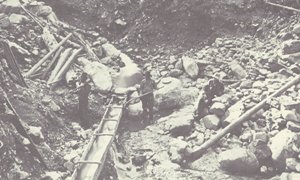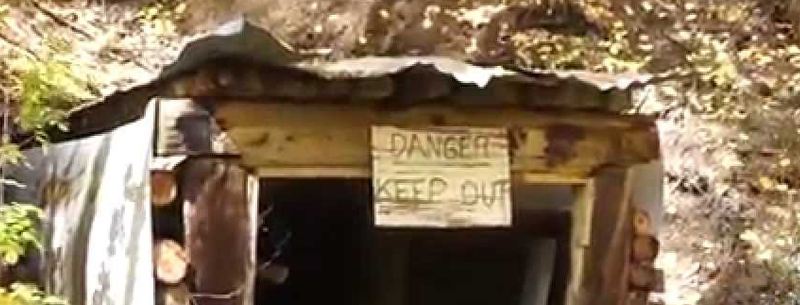When did the gold rush happen?
In 1859, the gold rush in Colorado began. Sutter’s Mill in California was the site of the first gold discovery in the west. This was in 1849. Imagine reading this exciting headline in your local paper: “Pikes Peak, Gold Excitement in the City, A New California”. Well, this news appeared in the Leavenworth Times, Kansas.
The entire eastern region of the United States was abuzz with talk of a new gold rush. “Pikes Peak or Bust” was the catchphrase of the time. When Sutter’s started to run out, the gold discovered at Pikes Peak sent a mass of migration to the area to mine for more gold. Easterners moved west and westerners in California moved east, all to meet up and search for prosperity.
GOLD! People get so excited about it they are consumed with getting rich and living their dreams. This precious metal affects most everyone the same way.
We felt it when we first moved into our house on a mountain here in Colorado. The shiny rocks and flakes of shimmering dust were all over our property. Wow! We’re rich! WRONG!
Just iron pyrite or fool’s gold. Oh well, it’s pretty when you sweep it off the floor or brush it out of the dog’s coats. Sorry, onward…
The Colorado Gold Rush Created Millionaires
Imagine the wagon trains heading west from Missouri into the unknown territory. Packing up your family and belongings, saying goodbye to your home, and traveling to a way of life that was hard work with difficult conditions. And dangerous.
Many gold miners heading for the rush struck it rich. However, there are a lot more who did not.
Oh, some hit a few thousand dollars worth of the ore, but not enough to sustain themselves and their families for long periods of time. These people packed up and returned east.
The Pikes Peak Gold Rush was a part of the race west during the Colorado gold rush. Denver City sprung up as tents and log cabins, housing the newly-arrived miners.
The 1859 gold rush happened so quickly there was no time to organize any local town government or law enforcement.
The miners were not concerned with this at all, they were prospecting. So they quickly formed mining districts. Their laws and their courts. Mining camps grew.
Colorado Gold Rush Towns
Cripple Creek, Georgetown, Fairplay, Breckenridge, and many others that are still present-day towns. Miners only wanted to dig for gold and had no use for farming or ranching.
When they had money, they needed supplies, clothes, food to survive. The miners would not leave their stake to get these staples.
In answer to the gold miners’ prayers, along came others bent on making their fortune, not with, Colorado gold mining, but supplying the miners with what they need.
Shopkeepers, saloon operators, blacksmiths, carpenters, all means of trade set up in the mining camps.
Life in the Colorado gold rush days was pretty rough and bawdy. Movies and TV only showed us the tamer side.
Also, another element was discovered along with gold. Silver was abundant in the mines where gold was discovered and many towns were founded based on this blue ore.
The most prosperous of the silver decade was the Leadville silver strike. And then the inevitable, the gold and silver were mined out and towns were abandoned.
Some once-booming towns became Colorado ghost towns. Names, rotted buildings, stone foundations, this is all that is left of the gold rush days.
Colorado Gold Mining
Colorado gold mining could not have been accomplished without the sweat and toil of the “fifty-Niners”. These men were named this because that was the year gold was discovered in Colorado, 1859. Out of the over 100,000 gold miners who traveled to Colorado in search of their fortune, only around 25,000 remained.

When these people arrived at the gold digs, they found the work hard, long, and tiring. The miners watched the old-timers who were more experienced at coaxing gold ore out of the ground. Old west miners used a pick, shovel, and plan to search for gold. It looked relatively easy to find gold this way.
When a likely spot containing traces of gold was found, the miners would stake their claim and the digging would commence. It worked like this: gravel was placed in the pan and would be washed. By swirling water around the pan and washing the gravel, the lighter substances would float away. Gold, which is a heavy metal, would stay in the pan. So gold would show up in the bottom of the pan.
Using a small pan was long and exhausting work. It would go faster if a larger pan was used. Miners were a smart bunch. The bigger pan became sluice boxes and rockers which allowed washing of more gold gravel in less time. This process was called placer mining or the mining of free gold. That which is found on the surface or in-stream beds.
Many miners started following the streams to find the source of the water and therefore, the source of gold. This process would lead them to the rocks and mountains. With the use of picks and shovels, they would carve out veins of gold ore. This was called hard rock mining. Other names were deep and quartz mining.
Trying to get into a deep vein of ore by hand was extremely long and tedious. Miners decided to blast the ore out of the mountain. It was dangerous work. Figuring how to get it out of the mountain after the rocks had been dynamited proved a large problem, but not one that stumped the miners for long.
A cage or elevator-like device was developed to get the ore from the mines to the surface. After the ore was brought to the surface it had to be crushed to separate the gold from the other minerals in the rock. Hard rock mining involved the use of more equipment, skillful miners, and people to run it and knowledge of how gold is mined. The hard rock process was much more expensive than placer mining.
As soon as miners began digging into the mountains, problems arose. Water would flood the mines and pumps were installed to get rid of it.
The tunnels had to be shored up by logs and wood beams to keep the soil from coming down on top of the workers. Another problem encountered by the miners was how to separate the gold from rock after it was brought to the surface. A stamp mill was used to crush the ore. That was the easy part. But it was soon found that most of the gold was lost with the waste from the crushing of the stamp mill.
Another way had to be devised to save all of the gold. No one knew what to do.
With all the problems of mining the gold, people started to get discouraged and began leaving Colorado in the mid 1860s.
Along came a gentleman named Nathan Hill. He was a chemistry professor back east.
He traveled to the territory to check on the family Colorado gold mining operations and saw how much trouble the miners were having. Something had to be done.
For three years, Mr. Hill experimented with different ideas until he came up with a process.
This device was called a smelter. He developed the process and opened the first smelter in Black Hawk near Central City in Colorado. It was the first in the territory.
Railroads arrived and tracks were laid between towns and mines so the gold could be transported quickly to the smelters and then on to mills all over the country.
With lots of hope, good luck, and ingenuity, Colorado gold mining has “panned” out (pardon the pun!) billions of dollars in gold ore since it was first discovered in 1859.
